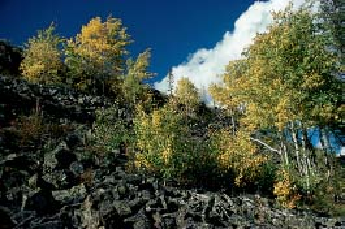Travel Reference
In-Depth Information
tops, a result of elk browsing on them in winter. There is an example of this tree that is more
than 1,500 years old growing at Mammoth Hot Springs.
One of the three deciduous trees at home in northern Yellowstone is the
quaking aspen
(Populus tremuloides),
which grows in sunny places on hillsides where there's abundant
groundwater. Aspens are distinguished by white trunks and by leaves that quake or shiver
in the slightest breeze due to flattened leafstalks. Fire does not destroy a stand of aspen, be-
cause the trees reproduce mainly by cloning from rhizomes, specialized horizontal root sys-
tems full of nutrients. One unexpected positive result of the 1988 fires was aspen's spreading
into burned-over meadows, where thick vegetation had previously crowded out any aspen
seedlings.
Aspens in autumn
Both of the area's other deciduous trees are types of cottonwood, the
narrowleaf cot-
tonwood
(Populus angustifolia)
and the
black cottonwood
or
balsam poplar
(Populus bal-
samifera).
Look for cottonwoods along the Lamar River and at the confluence of the Lamar
and Yellowstone Rivers. Black cottonwood have thick, furrowed, gray bark and trunks up to 3
feet (1 m) in diameter; the narrowleaf cottonwood is much smaller.
Valley shrubs and flowers
Many plants grow only in the park's lower elevations. For example, along all the rivers and
some creeks are many species of
willow
(Salix
spp.), which provide nutritious forage for elk,
as do the stems, leaves, and bark of the aspen. The shrub
Rocky Mountain maple
(Acer glab-
rum)
is found near Mammoth.
Y
ELLOW

